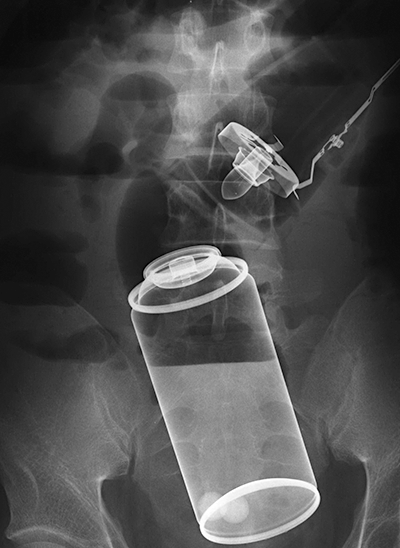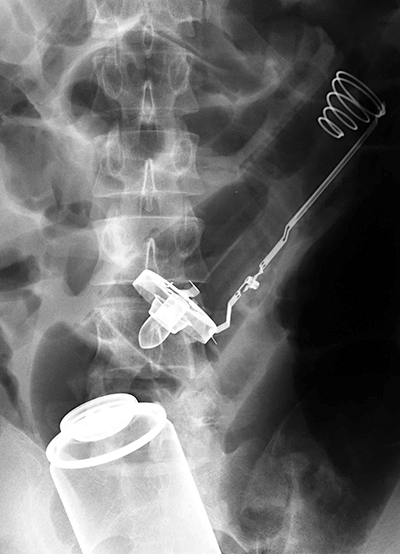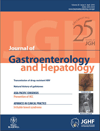Gastrointestinal: Colonic foreign bodies needing surgical removal
A 33-year-old man with autosynnoia presented at our clinic after an alleged sexual assault during which foreign bodies had been inserted into his rectum. He presented with abdominal pain which had lasted for 12 hours. Abdominal radiographs showed a spray can and a flashlight in the abdomen (1, 2). Inspection of the perianal area did not reveal any signs of trauma and no anal sphincteric abnormality was noted. Emergency surgery revealed perforation of the sigmoid colon. A flashlight and a spray can, consistent with the preoperative X-ray, were found. These objects were removed successfully following a partial sigmoidectomy. Munchausen syndrome was suspected.

Abdominal X-ray revealed a spray can and a head of a flashlight in the abdomen.

Abdominal X-ray revealed a head of a spray can and a flashlight in the abdomen.
Endoscopic removal of ingested foreign bodies is considered safe treatment for some colonic foreign bodies to avoid perforation of the gastrointestinal tract. Colorectal foreign bodies can also be introduced transanally. A similar case reported a patient suspected of Munchausen syndrome had inserted a spirit bottle into his rectum. This was, however, successfully removed using a Foley catheter passed through a rigid sigmoidoscope. In this case, an initial endoscopic attempt to remove the foreign bodies was abandoned as the objects were too large.
In a review of 93 cases of transanally-introduced retained colorectal foreign bodies, bedside extraction was successful in 74% of cases. The remaining 26% required management in the operating theatre. Two-thirds of the procedures were examinations under anesthesia and one-third were exploratory laparotomies. Of the 8 patients who underwent laparotomy, only one case allowed successfully delivery of the foreign body into the rectum for transanal extraction. The remaining cases required repair of the perforated bowel or extraction via colostomy. Retained foreign bodies in the sigmoid colon are more likely to require operative intervention than foreign bodies in the rectum (55% [6/11] versus 24% [17/70], P = 0.04). This case illustrated an example of multiple large foreign bodies in the sigmoid colon resulting in colonic perforation which required surgical management.
Contributed by




